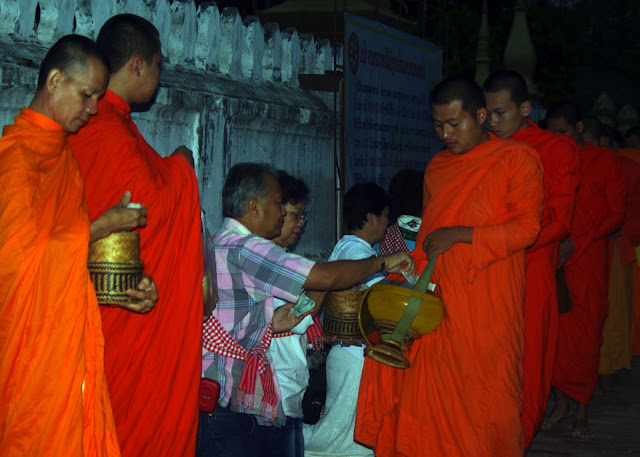We spent a week in Luang Prabang, a lovely city in the north of Laos. There are many temples in the city and hundreds of monks can be seen walking through the streets. Many of the buddhist monks are novices, young boys who spend several months to a year living with the monks and learning about Buddhism. Unique to Laos the monks carry umbrellas to shade them from the hot sun. I snapped this photo as 3 novices (ages about 13 and 10) walked down the street. They are not allowed to get within 3 meters of a woman so it is hard to get a photo! They live a simple life but we did see two of them playing a game on their i-phone.

The streets of the town are lined with boutique hotels, restaurants, cafes and handicraft shops. The night market is gigantic, we did lots of shopping - buying wood carvings, silver earrings and necklaces, fabric bags, aprons, t-shirts and toys that shoot up into the sky. We also spent a few afternoons relaxing in the cafes enjoying cafe lattes, frappes and pastries.
Kenna is trying on a traditional hill tribe necklace (no we did not buy it!).

The streets of the town are lined with boutique hotels, restaurants, cafes and handicraft shops. The night market is gigantic, we did lots of shopping - buying wood carvings, silver earrings and necklaces, fabric bags, aprons, t-shirts and toys that shoot up into the sky. We also spent a few afternoons relaxing in the cafes enjoying cafe lattes, frappes and pastries.
Kenna is trying on a traditional hill tribe necklace (no we did not buy it!).

This is the view of the city from the top of Phusi Hill where a small temple is located. In Luang Prabang the Mekong and Namkhan rivers joined together, creating lots of areas for riverfront cafes and restaurants. I even got to enjoy a yoga class on the riverfront during sunset.















































